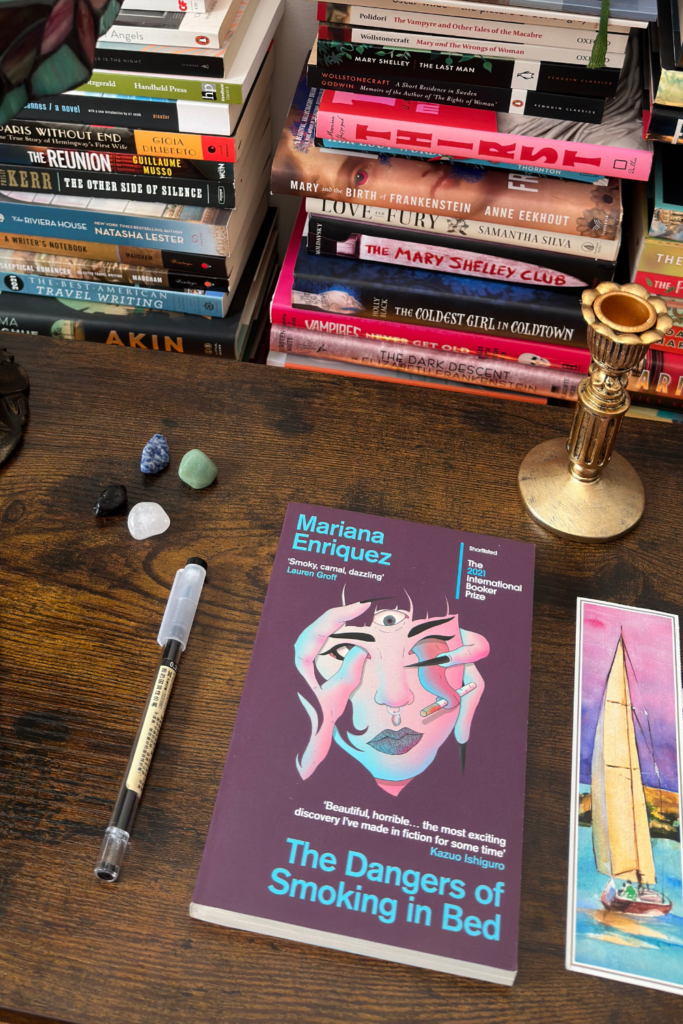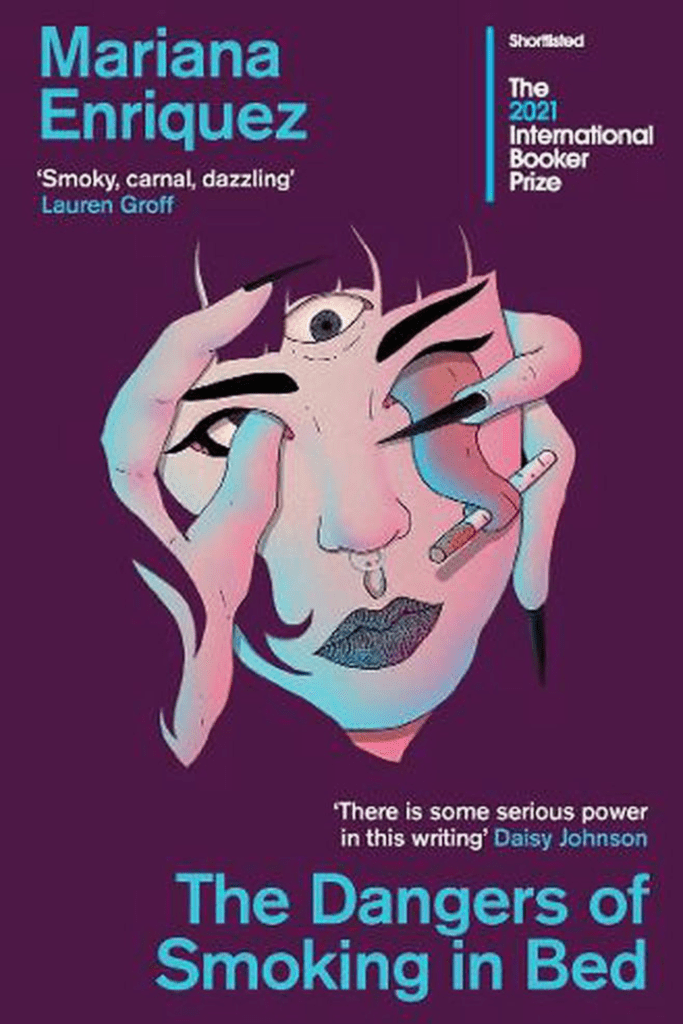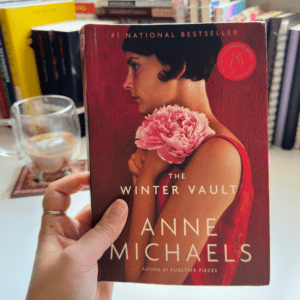This post may contain affiliate links, which means I’ll receive a commission if you purchase through my links, at no extra cost to you. Please read my full disclosure for more information.
“The Dangers of Smoking in Bed“ is the second short story collection of grotesque horror stories by the talented Argentinian writer Mariana Enríquez.

- Date finished: September 13th, 2024
- Pages: 189
- Format: Paperback
- Form: Short Stories
- Language read: Translated in English
- Series: Standalone
- Genre: Short Stories | Horror | Magical Realism
“The Dangers of Smoking in Bed“ is a collection of dark, unsettling, and, at times, grotesquely graphic stories set at the heart of Buenos Aires. Ghosts, superstitions, disappearing children, troubled teenagers, and more!

I greatly enjoyed “The Dangers of Smoking in Bed“ and highly recommend reading it during the spooky season. Enríquez’s writing style is both unapologetic and poetic.
Here are my ratings and brief thoughts about each story in this collection:
Story #1 “Angelita Unearthed” (3 ⭐️). Sometimes, her stories are a bit comical. In this one, the main character is haunted by a ghost when it rains.
Story #2 “Our Lady of the Quarry” (4 ⭐️). I always think of this story. I think I’ve read it about 3 times. The story accurately depicts female jealousy, desire, and wickedness, especially since it centers around teenagers. As we know, teenagers are deeply insecure and have a lot of internalized misogyny and ‘pick-meism’ to unpack.
“She was our “grown-up” friend, the one who took care of us when we went out and who let us use her place to smoke weed and meet up with boys. But we wanted her ruined, helpless, destroyed. Because Silvia always knew more: If one of us discovered Frida Kahlo, oh, Silvia had already visited Frida’s house with her cousin in Mexico, before he disappeared. If we tried a new drug, she had already overdosed on the same substance. If we discovered a band we liked, she had already gotten over being a fan of the same group.” (pp. 13-14)
Story #3 “The Cart” (2 ⭐️). Another story about a neighborhood haunting — a literal extended metaphor from a man who shits in the street to everything turns to shit on that very same street!
Story #4 “The Well” (3.5 ⭐️). Enríquez loves superstition. This one is about fear and familial betrayal. Enríquez once again doesn’t hold back from showing a victim’s unfortunate fate.
Story #5 “Rambla Triste” (4 ⭐️). The thing about Enríquez is that she’s incredibly smart and talented. She knows how to expertly interweave the injustice (and the politics) of her Argenetian background to reflect them on the oppressed and/or deeply troubled characters of her stories. In this case, the ghost children are victims; noting the rape of children, the erased records, and the pedophiles roaming free. The real becomes fantastical. I’ve noticed that oftentimes, she allows children (the most vulnerable members of our society) to have their revenge in her tales.
“It’s as if… What I’m about to say is insane. But what ever. Sometimes I think the crazies aren’t people, they’re not real. They’re like incarnations of the city’s madness, like escape valves. If they weren’t here, we’d all kill each other or die of stress, or, I don’t know, we’d go after those asshole city guards who won’t let you sit on the steps of the museum, or in the Plaza de los Angels… have you seen them? The fuckers go on raids, and around here it’s ‘antisocial behavior’ to sit on the sidewalk and drink a beer.” (p. 60)
Story #6 “The Lookout” (4.5 ⭐️). In this haunted hotel story, Enríquez takes the most vulnerable character and flat-out makes her the helpless victim. It’s so sinister that it’s almost comedic.
Story #7 “Where Are You, Dear Heart?” (4.5 ⭐️). This story is so original and utterly in·sane. I don’t foresee myself ever forgetting it as it has left a vast impression on me. The female main character loves the heartbeats of sick pulmonary people. Scratch that, she doesn’t only love. It actually turns her on.
“One week later I was suggesting to my friend that we visit Mara. I wanted to meet her dying brother, because I suspected that, well, that I could fall in love with him. But when I met him … the boy seemed sick enough, but I didn’t find him attractive. It was a confusing time for me, and I reached a conclusion that soothed my conscience: I didn’t like real sick people, and as such, I was not depraved. Those thoughts didn’t save me from my obsession. For an entire year I spent my allowance on expensive medical books, while my friends all spent theirs on drugs. Nothing brought me as much happiness as those books. All those euphemisms for death. All those beautiful medical terms that didn’t mean anything, all that hard jargon-that was pornography. By then I was pretty clear on what turned me on and what didn’t, and so I was increasingly bored by Victorian novels, where there was always some sick person but you never really knew what they were dying of. I was a little fed up with all the tuberculosis […]” (p. 90)
Story #8 “Meat” (4 ⭐️). Ah yes, more deranged teenagers. They cannibalized their dead rockstar idol and started a cult. Fantastic! Give me 12 more of these stories.
Story #9 “No Birthdays or Baptisms” (3.5 ⭐️). Disturbed filmmaker selling underage films of children. We meet a girl who compulsively cuts and masturbates and claims it’s someone else doing it to her. To this day, I’m not sure what’s going on with this story. I think that’s part of the appeal, the open-endedness of it all. The possibilities are endless for the readers to sort out.
Story #10 “Kids Who Come Back” (4.5 ⭐️). This was the longest story of the collection. Yet another story about kidnapped and missing children. And of course, they come back undead. (Are we sensing a theme?) This story is also a social commentary on how beauty makes us care more about a person, child, or young girl who’s gone missing. It’s messed up but true. We can say the same for people of different ethnic and socioeconomic classes who go missing.
Story #11 “The Dangers of Smoking in Bed” (2.5 ⭐️). This is the title story. I found it very short and not too memorable. Once again, another literal title and metaphor.
Story #12 “Back When We Talked to the Dead” (4 ⭐️). Ah yes, the famous Ouija board returns to entice and terrorize impressionable teenagers.
“We were scared, but fear doesn’t look the same as desperation.”
“A friend of ours was arrested because he painted a slogan that said, ‘Tourists, you’re the terrorists.”
⭐⭐⭐⭐






Leave a Reply